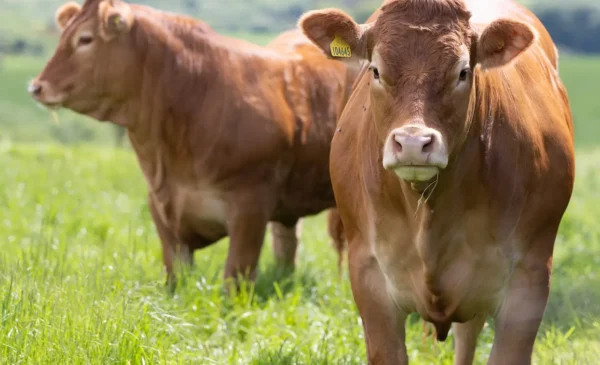What's the potential nutrient value in slurry and manure on your farm?
This section can help you to estimate the financial value of the total nutrients produced over the housed period and work out the N:P:K ratio.
Total or available…?
- Total nutrients refer to the amount of nutrients contained within the slurry or manure.
- Available nutrients refer to the amount available to the growing crop in the season of application
Keeping totals for slurry and manure separate, calculate the potential nutrient values contained in slurry and manure from housed livestock using Table 2 and Table 5, adding your values into Table 6.
Table 5. Typical values of dry matter and nutrient contents contained in livestock slurries and manures (From SAC Technical Note 650, 2013*).
| Manure Type | kg/t (solid manures) or kg/m3 (liquids and slurries) | ||||
| Dry matter (%) | Total N | Readily Available N | Total P2O5 | Total K2O | |
| Cattle FYM (fresh) | 25 | 6.0 | 1.2 | 3.20 | 8.00 |
| Cattle FYM (old) | 25 | 6.0 | 0.6 | 3.20 | 8.00 |
| Cattle Slurry | 6. | 2.6 | 1.20 | 1.20 | 3.20 |
| Sheep FYM (fresh) | 25 | 7.0 | 1.4 | 3.2 | 8.0 |
| Sheep FYM (old) | 25 | 7.0 | 0.70 | 3.20 | 8.0 |
| Pig FYM (fresh) | 25 | 7.0 | 1.80 | 6.00 | 8.00 |
| Pig FYM (old) | 25 | 7.0 | 1.00 | 6.00 | 8.00 |
| Pig slurry | 4 | 3.6 | 2.50 | 1.80 | 2.40 |
| Broiler/ turkey litter | 60 | 30 | 10.5 | 25 | 18 |
| Duck FYM (fresh) | 25 | 6.5 | 1.6 | 5.5 | 7.5 |
| Duck FYM (old) | 25 | 6.5 | 1.0 | 5.5 | 7.5 |
| Horse FYM | 30 | 7.0 | 0.7 | 0.5 | 6.0 |
(*Since this document was prepared, SAC Technical Note TN650 has been replaced by FAS Technical Note TN736)
Calculating Total N produced by housed livestock
To calculate the Total N in slurry or manure for each livestock type, use Table 6. Two examples have been included for reference.
- Write livestock type, whether it is a slurry or manure and the number of livestock in the first three columns.
- Put the volume of slurry or manure (m3) produced per week (from Table 2), into column 4 and the number of weeks you have the livestock is housed in column 5.
- Use Table 5 to get the reference value for Total N in slurries (kg per 1 m3) or manures (kg in 1 t) produced by 1 livestock.
- Work along the row to multiply the number of livestock by the volume of slurry or manure produced and multiply again by the number of housed weeks. Then multiply by the Total N in the slurry produced by 1 animal, putting the total in column 7.
This will give you an estimation of the Total N (kg) contained in the slurry or manure over the housed period.
Table 6. Total N produced from the slurry or manure for each livestock type.
| 1 | 2 | 3 | 4 | 5 | 6 | 7 |
| Type of livestock | Slurry or manure? | Number of livestock | Volume of slurry or manure (m3/week) (from Table 2) | Number of weeks housed | Total N in slurry (kg in 1 m3) or in manure (kg in 1 t) produced by 1 livestock (from Table 5) | Total N produced (kg) from manure or slurry over housed period |
| Dairy cow (> 9000 L milk yield) | Slurry | 100 | x0.45 | x 26 | x 2.6 | = 3042 |
| 1 Steer/ heifer 3 to 13 months | FYM (fresh) | 100 | x 0.14 | x 26 | x 6.0 | = 2184 |
| x | x | x | = | |||
| x | x | x | = | |||
| x | x | x | = | |||
| x | x | x | = | |||
| *Total N produced by all livestock (kg) | = | |||||
Example:
To calculate the Total N in the volume of slurry produced by 100 dairy cows (> 9000 L of milk yield):
- Multiply the number of livestock (100) by the volume of slurry produced in a week (0.45 m3/week) to get a weekly amount = 45 m3/week.
- Multiply the weekly amount of slurry produced by livestock (45 m3/week), by the number of weeks that they are housed (26 weeks in this example). This will give the total volume of slurry produced = 1,170 m3 over the housed period.
- Multiply by the Total N in slurry (kg in 1 m3) taken from the reference Table 5 (2.6 kg/m3) by the total volume of slurry produced (1,170 m3) to work out the Total N produced from the slurry (kg) over the housed period = 3,042 kg total N produced.
*Note this is the total N and has been included for illustration. Losses may occur during storage, handling and application method
Calculating Total P2O5 produced by housed livestock
To calculate the Total P2O5 produced from slurries or manures for each livestock type, complete Table 7:
- Write livestock type, whether it is a slurry or manure and the number of livestock in the first three columns.
- Write down the volume of slurry or manure (m3) produced per week (From Table 2) in column 4 and the number of weeks the livestock is housed in column 5.
- Use Table 5 to get the reference value for Total P2O5in slurry (kg per 1 m3) or manure (kg in 1 t) produced by 1 livestock.
- Work along the row to multiply the number of livestock by the volume of slurry or manure produced and multiply again by the number of housed weeks.
- Multiply by the Total P2O5in the slurry produced by 1 livestock, putting the total in column 7.
This will give you an estimation of the Total P2O5 produced (kg) from the slurry or manure over the housed period.
Table 7. Total P2O5 produced from the slurry or manure for each livestock type.
| 1 | 2 | 3 | 4 | 5 | 6 | 7 | |
| Type of livestock | Slurry or manure? | Number of livestock | Volume of slurry or manure (m3/week) (from Table 2) | Number of weeks housed | Total P2O5 in slurry (kg in 1 m3) or in manure (kg in 1 t) produced by 1 livestock (from Table 5) | Total P2O5 produced (kg) from manure or slurry over housed period | |
| Dairy cow (> 9000 L milk yield) | Slurry | 100 | x 0.45 | x 26 | x 1.20 | = 1404 | |
| 1 Steer/ heifer 3 to 13 months | FYM (fresh) | 100 | x 0.14 | x 26 | x 3.2 | = 1164.8 | |
| x | x | x | = | ||||
| x | x | x | = | ||||
| x | x | x | = | ||||
| x | x | x | = | ||||
| Total P2O5 produced by all livestock (kg) | = | ||||||
Calculating Total K2O produced from housed livestock
To calculate the Total K2O produced from slurries or manures for each livestock type, use Table 8.
- Record the livestock type, whether it is slurry or manure and the number of livestock in the first three columns.
- Write down the volume of slurry or manure (m3) produced per week (from Table 2), into column 4 and the number of weeks the livestock is housed in column 5.
- Use Table 5 to get the reference value for Total K2O in slurries (kg per 1 m3) or manures (kg in 1 t) produced by 1 livestock.
- Working across the row, multiply the number of livestock by the volume of slurry or manure produced and multiply again by the number of housed weeks.
- Multiply by the Total K2O in the slurry produced by 1 livestock, putting the total in column 7.
This will give you an estimation of the Total K2O produced (kg) from the slurry or manure over the housed period.
Table 8. Total K2O produced from the slurry or manure for each livestock.
| 1 | 2 | 3 | 4 | 5 | 6 | 7 |
| Type of livestock | Slurry or manure? | Number of livestock | Volume of slurry or manure (m3) (from Table 2) | Number of weeks housed | Total K2O in slurry (kg in 1 m3) or in manure (kg in 1 t) produced by 1 livestock (from Table 5) | Total K2O content of slurry or manure produced (kg) over housed period |
| Dairy cow > 9000 L milk yield) | Slurry | 100 | x 0.45 | x 26 | x 6.00 | = 7020 |
| 1 Steer/ heifer 3 to 13 months | FYM (fresh) | 100 | x 0.14 | x 26 | x 8.0 | = 2912 |
| x | x | x | = | |||
| x | x | x | = | |||
| x | x | x | = | |||
| x | x | x | = | |||
| Total K2O produced by all livestock (kg) | = | |||||
Converting Total P2O5 to Total P and Total K2O to Total K
Using Table 9, write in the Total N (from Table 6), Total P2O5 (from Table 7) and Total K2O (from Table 8) of the various slurries and manures produced.
- Write down the type of livestock and manure or slurry in the first two columns.
- From Table 6, write the Total N content for that livestock in kg in column 3.
- From Table 7, write the Total P2O5(kg) for each livestock type into column 4.
- From Table 8, write the Total K2O (kg) content into column 6.
The Total P and Total K contents must be calculated first before calculating the N:P:K ratio:
- Multiply the Total P2O5 content for each livestock type by 0.436 and write it in column 5 to give the Total P content of the slurry or manure.
- The Total K can be calculated by multiplying the Total K2O value in column 6 by 0.830 and written in column 7.
Table 9. Total nutrients and NPK ratio produced from the slurry or manure for each livestock.
| 1 | 2 | 3 | 4 | 5 | 6 | 7 | 8 |
| Type of livestock | Slurry or manure? | Total N content of slurry or manure produced (kg) (From Table 6) | Total P2O5 content of slurry or manure produced (kg) (From Table 7) | Total P content (multiply P2O5 value by 0.436) | Total K2O content of slurry or manure produced (kg) (From Table 8) | Total K content (multiply K2O value by 0.830) | Ratio of NPK from columns 3, 5 and 7) (divide by smallest value) |
| Dairy cow
(> 9000 L milk yield) |
Slurry | 3042 | 1404 | 612.1 | 7020 | 582.6 | 4.97 : 1 :9.5 |
| 1 Steer/ heifer 3 to 13 months | FYM (fresh) | 2184 | 1164.8 | 507.85 | 2912 | 2416.96 | 4.3 : 1 :4.76 |
| Total nutrients produced by all livestock types | = | ||||||
Example:
In the example, dairy cow (> 9000 L milk yield) slurry production contained the following nutrients (kg):
- Total N (Table 6) = 3,042.
- Total P2O5(Table 7) = 1,404.
- Total K2O (Table 8) = 7,020.
These are written into Table 9 in columns 3, 4 and 6. To calculate the Total P and Total K content of the slurry (kg):
- Multiply the Total P2O5value in column 4 (1,404) by 0.436 to give a value for Total P = 612.1.
- Next, multiply the Total K2O in column 6 (7,020) by 0.830 to get the Total K value = 5,826.6.
For this example, the table should contain:
- Total N (column 3) = 3,042.
- Total P (column 5) = 612.1.
- Total K (column 7) = 5,826.6.
Working out N:P:K ratios
To calculate the N:P:K ratio of the slurry or manure for each livestock type, look at all three values in columns 3, 5 and 7 and find the smallest number. To get the ratio, divide them all by the smallest number. In this example, the smallest value is for the Total P at 612.1. Divide the Total N, P and K values by 612.1 as shown here:
- Total N (column 3) = 3,042 / 612.1 = 4.97.
- Total P (column 5) = 612.1 / 612.1 =1.0
- Total K (column 7) = 5,826.6 / 612.1 = 9.5.
Therefore the slurry NPK ratio is 4.97 : 1 : 9.5 This ratio can be written in column 8 in Table 9.
Your figures in Table 9 now provide a useful estimate of the potential total N, P2O5 and K2O and Total P and K produced by your housed livestock along with N:P:K ratios of different livestock slurries and manures.
Estimating the financial value of total nutrients
To estimate the financial value of the nutrients take the total P value and multiply this by the cost of P per kg (around 68p/kg P2O5 at current prices). This gives the purchase cost of the equivalent amount of P fertiliser. Use the same method to estimate K, using the price per kg (around 45p/kg K2O at current prices).
Often, all crop requirements for P and K can be met through wise slurry and manure application, saving on your fertiliser bill. Calculations for estimation of available N have not been included in the tables, as many factors can influence these levels.
An agricultural consultant will be able to look at nutrient balances on your farm in detail, highlighting opportunities to improve nutrient use, save money and improve your environmental performance.
Computer programs such as MANNER-NPK and PLANET Scotland are available to calculate approximate N values within slurry and manure enabling you to make your own adjustments to N application.
This information is updated and abridged from The 4 Point Plan (2003).
Related resources

Better Nutrient use: Working it Out
After completing this section, you will know the amount of slurry and manure1 generated by your…

Managing Water Margins
How we manage land can have a big impact on surrounding water quality. Spreading operations…


